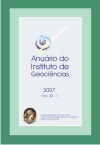Influence of high and low pressure systems and Sea Surface Temperature of South Atlantic in the development of Mesoscale Convective Systems in Rio Grande do Sul
DOI:
https://doi.org/10.11137/2007_2_31-44Abstract
In this work the influences of the positioning of high and low pressures systems centers at South Atlantic Ocean and Sea Surface Temperature (SST) anomalies of Atlantic and Pacific Oceans are analysed in association to the occurrence of Mesoscale Convective Systems (MCS) in Rio Grande do Sul (RS) State. The selected period involves four years of February (2002-2005). It was utilized geostationary satellite imagery, values of Sea Surface Temperature (SST) anomalies of the Atlantic and Pacific Oceans and pluviometric precipitation data observed on the State. The horizontal fields of atmospheric pressure and streamslines were obtained from simulations made with the mesoscale model MM5. The results showed that for the analysed period there was one rainy February in the State and three months of drought. For the drought months, the number of observed MCS was inferior, up to six times, to the observed one in the rainy month. Still, in the dry months, the MCS presented shorter duration in relation to the ones observed in the rainy February. For all the analysed period, the MCS dissipation occurred to the east of its position of formation, in the majority of the cases. Although the differences found between all the analysed MCS, the preferential time in which they formed, 12 and 18 UTC, predominated in all period. The large scale and mesoscale circulation patterns had shown that in the rainy month, the centers of subtropical high pressure systems located on the Atlantic Ocean were positioned near the SSA coast, where the SST anomalies values were positive. The opposite were observed during the drought months.Downloads
Download data is not yet available.
Downloads
Published
2007-12-01
How to Cite
Scaglioni, T. P., Gomes, R. G. and Marques, J. R. Q. (2007) “Influence of high and low pressure systems and Sea Surface Temperature of South Atlantic in the development of Mesoscale Convective Systems in Rio Grande do Sul”, Anuário do Instituto de Geociências. Rio de Janeiro, BR, 30(2), pp. 31–44. doi: 10.11137/2007_2_31-44.
Issue
Section
não definida
License
This journal is licensed under a Creative Commons — Attribution 4.0 International — CC BY 4.0, which permits use, distribution and reproduction in any medium, provided the original work is properly cited.















